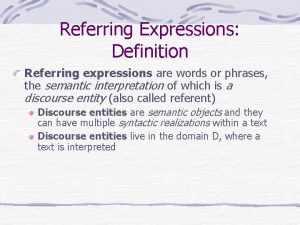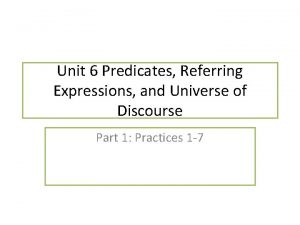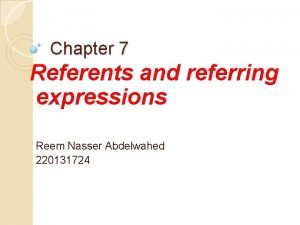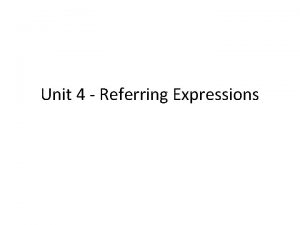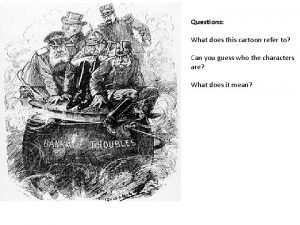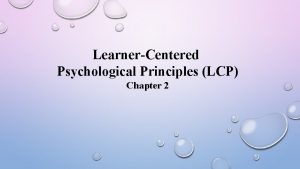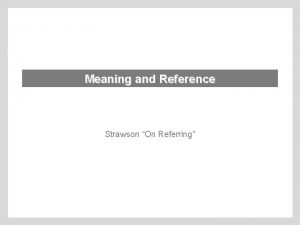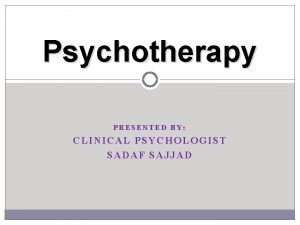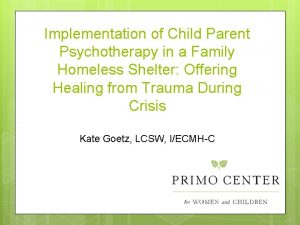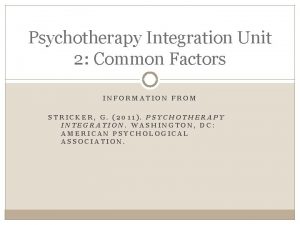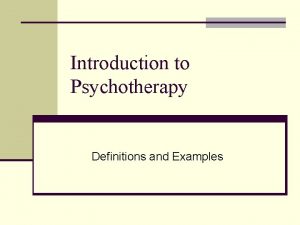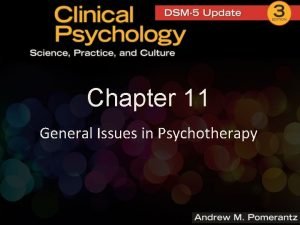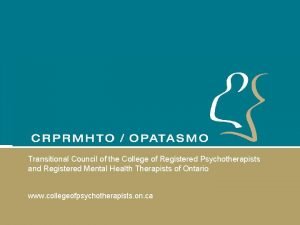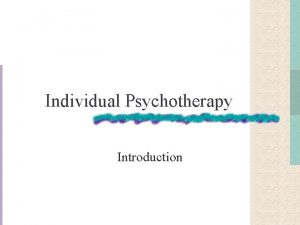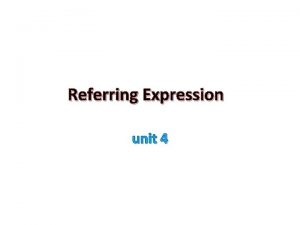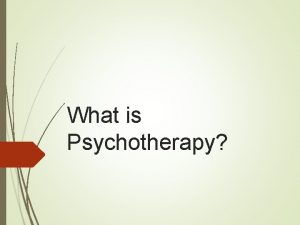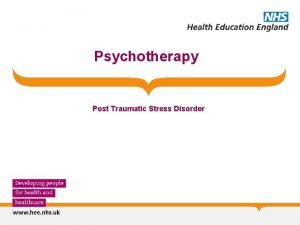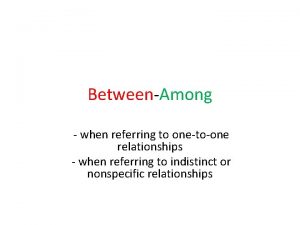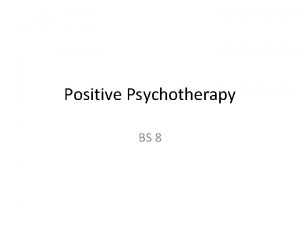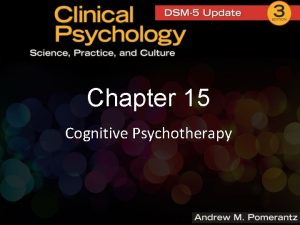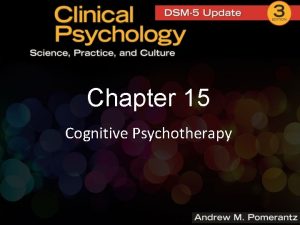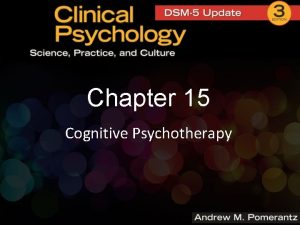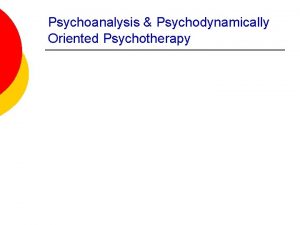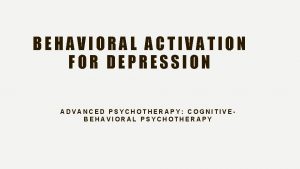Psychotherapy Referring to Psychotherapy Referring to Psychotherapy Aims


































- Slides: 34

Psychotherapy Referring to Psychotherapy

Referring to Psychotherapy Aims and Objectives (from handbook) • Identify relevance to psychotherapy of particular aspects of the psychiatric history. • Account for psychiatric presentation in psychological terms. • Know when to refer patients appropriately to specialist services

Referring to Psychotherapy To achieve this • • • Case Presentation Journal Club 555 Presentation Expert-Led Session MCQs • Please sign the register and complete the feedback

Referring to Psychotherapy Expert Led Session Psychotherapy Assessment Author: Dr. Adam Dierckx Consultant Medical Psychotherapist

What will we cover? • What therapy for whom? • Where to refer. • What can your patient expect from assessment? • Mop up from afternoon

What Therapy For Whom? • By Diagnosis • By NICE Guidance • ‘Real life’

Therapy by diagnosis • ICD-10 – Organic: supportive and systemic for carers – Substance misuse: MI, groups (e. g. AA, TC) – Psychosis: Cognitive Tx, Family Tx – Affective Disorders: CBT, psychotherapy – Anxiety Disorders: CBT – Behavioural Disorders: CBT – Personality Disorders: Adapted dynamic therapies

By NICE Guidance • Follows broad outline in previous slide • Significant limitations for psychological therapy guidance. – Not all conditions have guidance – Most guidance is not exhaustive – what next?

Practical Guide: Where to refer? • Cognitive & Behavioural Therapies • Primary Care – IAPT – Mainly mild – moderate – Affective and anxiety disorders – Mainly shorter term presentations – No previous therapy • Secondary Care – Clinical Psychology – More complex and/or severe cases – Lack of effect from previous therapy – Longer presentations

Practical Guide: Where to refer? (2) • Psychotherapy • • Chronicity Complexity Comorbidity Counter-transference

What happens in an assessment? • • • Diagnosis / Formulation Engagement Therapeutic change Consent Treatment planning

Formulation • Synthesis of historical information – Current presentation – Past History • Exploration of coping mechanisms • Emphasis on interpersonal events • An attempt to explain why the patient’s illness looks like it does.

History of Presenting Complaint • What is the problem the patient wants addressing? • What is the problem the referrer wants addressing (if different)? • When did it start and how? • What is the interpersonal context? • Has it happened before? Any patterns?

Triangle of Conflict • Information from HPC

Past History • What is the story of the patient’s life? – Brief and in general terms • Family structure and relationships with family • Attachment disruption e. g. CSA, loss, LAC • How do they get on with people? – Adolescent and adult relationships – stability/chaos • What do they do with their life now?

Triangle of Person • Information from PH and other history

Full Formulation • Combine both Triangles

Engagement • Motivation & Readiness • Attachment Style • Aims and focus for therapy

Motivation & Readiness

Attachment Style: Adaptations • Secure – Attaches easily with appropriate boundaries • Insecure: Ambivalent – Alternately help seeking and rejecting – Needs consistency & gently firm boundaries • Insecure: Avoidant – Hard to engage, avoids care – Needs encouragement and not mistaking avoidance for not wanting help • Disorganized – Chaotic – Needs stabilization first

Therapeutic Change • Movement in motivation stage • Increased insight • Revised care plans

Consent & Planning • Consent – Trial of therapy – Experience of the process – Assessment of reaction to assessment • Planning – Collaborative care plan – Based on trial of therapy

Summary • What therapy for whom? • Where to refer. • What can your patient expect from assessment?

Psychotherapy MCQs 1. The following theorists are correctly matched with the concepts that they introduced: • • • Sigmund Freud Melanie Klein David Malan Herbert Rosenfeld Anna Freud The Subconscious The Paranoid-Schizoid Position The Two Triangle technique Containment The Ego

Psychotherapy MCQs 1. The following theorists are correctly matched with the concepts that they introduced: • • • Sigmund Freud Melanie Klein David Malan Herbert Rosenfeld Anna Freud The Subconscious The Paranoid-Schizoid Position The Two Triangle technique Containment The Ego

Psychotherapy MCQs 2. Defences: • • • Are always pathological. Reduce anxiety. Enhance conscious insight. Are universal. Develop later in childhood.

Psychotherapy MCQs 2. Defences: • • • Are always pathological. Reduce anxiety. Enhance conscious insight. Are universal. Develop later in childhood.

Psychotherapy MCQs 3. A psychotherapy formulation: • • • Leads to a diagnosis. Ignores the past. Is only applicable in psychotherapy. Is theory neutral. Makes predictions.

Psychotherapy MCQs 3. A psychotherapy formulation: • • • Leads to a diagnosis. Ignores the past. Is only applicable in psychotherapy. Is theory neutral. Makes predictions.

Psychotherapy MCQs 4. How do you define transference? • • • The empathy shown by therapist to the patient. Defence mechanism where attention is shifted to a less threatening / more benign target. Therapist’s response to the patient drawn from therapist’s previous life experiences. Patient’s response to therapist based upon their earlier relationships All of the above

Psychotherapy MCQs 4. How do you define transference? • • • The empathy shown by therapist to the patient. Defence mechanism where attention is shifted to a less threatening / more benign target. Therapist’s response to the patient drawn from therapist’s previous life experiences. Patient’s response to therapist based upon their earlier relationships All of the above

Psychotherapy MCQs 5. What would suggest a patient has good psychological mindedness? • • • Becoming very upset when talking about the past Finding it hard to step back and observe the situation objectively Needing to be talked through assessment with lots of prompts Reasonable sense of self esteem None of the above

Psychotherapy MCQs 5. What would suggest a patient has good psychological mindedness? • • • Becoming very upset when talking about the past Finding it hard to step back and observe the situation objectively Needing to be talked through assessment with lots of prompts Reasonable sense of self esteem None of the above

Psychotherapy Any Questions? Thank you.
 Referring others
Referring others Summary of to daffodils
Summary of to daffodils Contextual references
Contextual references Referring expression definition
Referring expression definition Referring expression
Referring expression Proclaiming and referring tones
Proclaiming and referring tones Referring expression
Referring expression Diversity of a different kind
Diversity of a different kind Referring expression example
Referring expression example The second moroccan crisis of 1911 resulted in
The second moroccan crisis of 1911 resulted in What kind of “trouble” was hitesh referring to
What kind of “trouble” was hitesh referring to 3 principles of motivational and affective factors
3 principles of motivational and affective factors On referring strawson
On referring strawson Transference in psychotherapy
Transference in psychotherapy Difference between guidence and counselling
Difference between guidence and counselling Psychotherapy definition
Psychotherapy definition Cpp triangle of explanation
Cpp triangle of explanation Common factors approach psychotherapy integration
Common factors approach psychotherapy integration Psychotherapy examples
Psychotherapy examples General issues in psychotherapy
General issues in psychotherapy Counselling psychology doctorate
Counselling psychology doctorate Andrew pethebridge
Andrew pethebridge Counselling ppt
Counselling ppt Introduction to psychotherapy ppt
Introduction to psychotherapy ppt Padesky 5 aspects. 1986
Padesky 5 aspects. 1986 Limitations of psychotherapy
Limitations of psychotherapy Carl rogers 19 propositions
Carl rogers 19 propositions Dr barbara combines techniques from humanistic
Dr barbara combines techniques from humanistic World council for psychotherapy
World council for psychotherapy Quantum psychotherapy
Quantum psychotherapy What is ethical bracketing
What is ethical bracketing College of registered psychotherapists of ontario
College of registered psychotherapists of ontario Psychotherapy refers to
Psychotherapy refers to Types of individual psychotherapy
Types of individual psychotherapy The primary goal of cognitive psychotherapy is
The primary goal of cognitive psychotherapy is



